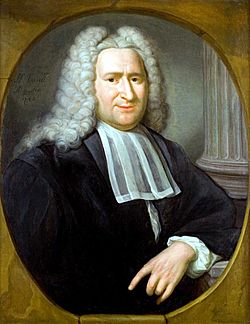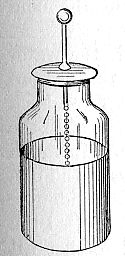Pieter van Musschenbroek facts for kids
Quick facts for kids
Pieter van Musschenbroek
|
|
|---|---|

1741 portrait of Pieter van Musschenbroek
|
|
| Born | 14 March 1692 |
| Died | 19 September 1761 (aged 69) |
| Nationality | Dutch |
| Alma mater | Leiden University |
| Known for | Leyden jar, Tribometer, Atmometer |
| Scientific career | |
| Fields | Physics, mathematics, philosophy, medicine, astronomy |
| Doctoral advisor | Wolferd Senguerd Herman Boerhaave |
| Notable students | Andreas Cunaeus |
Pieter van Musschenbroek (born March 14, 1692 – died September 19, 1761) was a Dutch scientist. He was a professor who taught many subjects like mathematics, philosophy, medicine, and astronomy in different cities such as Duisburg, Utrecht, and Leiden.
He is famous for inventing the Leyden jar in 1746. This was the first device that could store electricity. He also studied how materials bend or break under pressure. Musschenbroek was one of the first scientists to describe machines that tested how strong materials were. These machines checked if materials could handle pulling, pushing, or bending.
Contents
Early Life and Education
Pieter van Musschenbroek was born on March 14, 1692, in Leiden, Dutch Republic. His father, Johannes van Musschenbroek, was a skilled instrument maker. He built scientific instruments like air pumps, microscopes, and telescopes.
Pieter went to Latin school until 1708. There, he learned many languages, including Greek, Latin, French, English, German, Italian, and Spanish. He later studied medicine at Leiden University and earned his doctorate in 1715. He also attended lectures by famous scientists like Isaac Newton in London. He finished his studies in philosophy in 1719.
Academic Career
Teaching in Duisburg
In 1719, Pieter van Musschenbroek became a professor of mathematics and philosophy at the University of Duisburg. Two years later, in 1721, he also became a professor of medicine there.
Moving to Utrecht
In 1723, he left Duisburg and became a professor at the University of Utrecht. By 1726, he also taught astronomy. His book, Elementa Physica (published in 1726), was very important. It helped spread Isaac Newton's ideas about physics across Europe. In November 1734, he was chosen to be a Fellow of the Royal Society, a famous scientific group.
Return to Leiden

In 1739, Musschenbroek returned to his hometown of Leiden. He took over as a professor at Leiden University.
While studying at Leiden University, he became very interested in electrostatics, which is the study of electric charges that are not moving. At that time, scientists could create electric energy using friction machines, but they couldn't store it.
Musschenbroek and his student, Andreas Cunaeus, discovered a way to store this energy. They used a glass jar filled with water with a brass rod inside. The stored energy could be released by connecting the brass rod to something outside the jar, like a hand.
Van Musschenbroek shared his discovery in January 1746. A translator named Abbé Nollet named the invention the 'Leyden jar' after the city of Leiden. Soon after, it was found that a German scientist, Ewald Georg von Kleist, had made a similar device independently a little earlier.
Musschenbroek also made important contributions to the study of tribology, which is about friction, wear, and lubrication between surfaces.
In 1754, he became an honorary professor at the Imperial Academy of Science in Saint Petersburg. He was also elected a foreign member of the Royal Swedish Academy of Sciences in 1747.
Pieter van Musschenbroek passed away on September 19, 1761, in Leiden.
Works
- Elementa Physica (1726)
- Dissertationes physicae experimentalis et geometricae de magnete (1729)
- Tentamina experimentorum naturalium in Accademia del Cimento (1731)
- Institutiones physicae (1734)
- Beginsels der Natuurkunde, Beschreeven ten dienste der Landgenooten, door Petrus van Musschenbroek, Waar by gevoegd is eene beschryving Der nieuwe en onlangs uitgevonden Luchtpompen, met haar gebruik tot veel proefnemingen (1736 / 1739)
- Aeris praestantia in humoribus corporis humani (1739)
- (in la) De fluido. Leiden: Gerrit Potvliet. 1743. https://gutenberg.beic.it/webclient/DeliveryManager?pid=8671928.
- Oratio de sapientia divina (1744)
- Institutiones physicae conscriptae in usus academicos (in Latin). Lugduni Batavorum : Apud S. Luchtmans et filium, 1748.
- (in la) Dissertatio physica experimentalis de magnete. Wien: Johann Thomas von Trattner (1.). 1754. https://gutenberg.beic.it/webclient/DeliveryManager?pid=625928.
- (in la) Physicae experimentales et geometricae dissertationes. Wien: Johann Thomas von Trattner (1.). 1755. https://gutenberg.beic.it/webclient/DeliveryManager?pid=12779918.
- (in la) Elementa physicae conscripta in usus academicos. Venezia: Giovanni Battista Remondini. 1761. https://gutenberg.beic.it/webclient/DeliveryManager?pid=795622.
- Institutiones logicae (1764)
- (in la) Elementa physicae conscripta in usus academicos. Napoli: Giovanni Francesco Paci. 1771. https://gutenberg.beic.it/webclient/DeliveryManager?pid=12814691.
- (in la) Elementa physicae conscripta in usus academicos. Bassano: Remondini. 1781. https://gutenberg.beic.it/webclient/DeliveryManager?pid=6601532.
- (in la) Introductio ad philosophiam naturalem. 1. Padova: Tipografia del Seminario. 1824. https://gutenberg.beic.it/webclient/DeliveryManager?pid=606798.
- (in la) Introductio ad philosophiam naturalem. 2. Padova: Tipografia del Seminario. 1824. https://gutenberg.beic.it/webclient/DeliveryManager?pid=607809.
Images for kids
See also
 In Spanish: Pieter van Musschenbroek para niños
In Spanish: Pieter van Musschenbroek para niños



